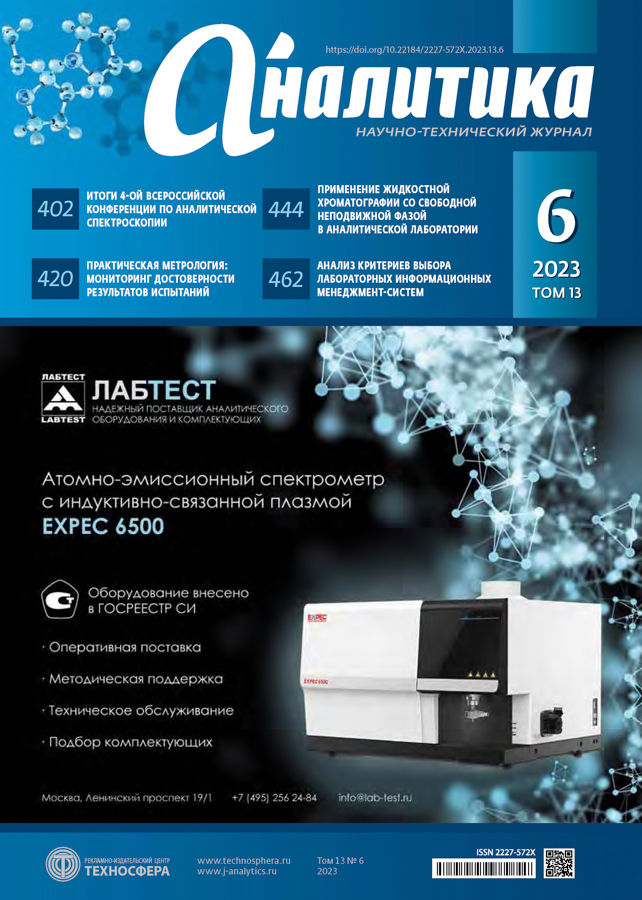О поверке, калибровке приборов, аттестации методик и достоверности результатов химико-аналитических измерений
- Авторы: Крылов А.И.1, Лазаренко Е.Р.1
-
Учреждения:
- ФГУП «Всероссийский научно-исследовательский институт метрологии им. Д. И. Менделеева»
- Выпуск: Том 13, № 6 (2023)
- Страницы: 428-434
- Раздел: Метрология химического анализа
- URL: https://journals.eco-vector.com/2227-572X/article/view/631395
- DOI: https://doi.org/10.22184/2227-572X.2023.13.6.428.434
- ID: 631395
Цитировать
Полный текст
Аннотация
Основные пути достижения достоверности (единства) результатов измерений, согласно существующим регламентам, связаны, в основном, с поверкой приборов, их калибровкой или воспроизведением метрологически аттестованных методик измерений. В части, касающейся измерений количества вещества, не всегда традиционные подходы являются оптимальными. Так, для специфических анализаторов, ряда электрохимических приборов и т. п. выполнение поверки является вполне оправданным и необходимым элементом получения достоверных результатов измерений. При воспроизведении (или разработке) методик, реализуемых на «универсальных» приборах, в первую очередь, речь должна идти о построении градуировочных характеристик (специфичных для каждого конкретного вещества), соблюдении режимов пробоподготовки и т. п. В этом случае целесообразность выполнения поверки прибора становится по крайней мере сомнительной. На получение адекватных результатов в большей мере влияют наличие и применение соответствующих средств градуировки: стандартных образцов – СО (чистые вещества или их растворы), средств контроля полученных данных – СО «матричного» типа, а также аттестованных методик измерений. Таким образом, в области химико-аналитических измерений возникает необходимость пересмотра перечня приборов, подлежащих обязательной поверке, и одновременно целесообразность более активного развития направления работ по существенному расширению списка СО, включая СО матричного типа.
Полный текст
Об авторах
А. И. Крылов
ФГУП «Всероссийский научно-исследовательский институт метрологии им. Д. И. Менделеева»
Автор, ответственный за переписку.
Email: a.i.krylov@vniim.ru
доктор химических наук
Россия, Санкт-Петербург
Е. Р. Лазаренко
ФГУП «Всероссийский научно-исследовательский институт метрологии им. Д. И. Менделеева»
Email: a.i.krylov@vniim.ru
Россия, Санкт-Петербург
Список литературы
- Федеральный закон от 26 июня 2008 года № 103 – ФЗ «Об обеспечении единства измерений» (с изменениями на 11 июня 2021 года).
- Приказ Министерства промышленности и торговли Российской Федерации № 4091 от 15 декабря 2015 года «Об утверждении Порядка аттестации первичных референтных методик (методов) измерений, референтных методик (методов) измерений и методик (методов) измерений и их применения».
- Приказ Министерства промышленности и торговли Российской Федерации № 2905 от 28 августа 2020 года «Об утверждении порядка проведения испытаний стандартных образцов для средств измерений в целях утверждения типа, порядка утверждения типа стандартных образцов или типа средств измерений, внесения изменений в сведения о них порядка выдачи сертификатов об утверждении типа стандартных образцов или типа средств измерений, формы сертификатов об утверждении типа стандартных образцов или типа средств измерений, требования к знакам утверждения типа стандартных образцов или типа средств измерений и порядка их нанесения».
- Болдырев И. В. Проект нового кодекса РФ об административных правонарушениях. Кто виноват и что делать? Аналитика. 2020; 10 (3): 244–250.
- Болдырев И. В. Аккредитация – объективный путь к надежным и достоверным результатам испытаний, Аналитика. 2022; 12 (2): 96–101.
- Новиков Е. А. Как обеспечить единство измерений. Журнал аналитической химии. 2012; 67 (12): 1091–1096.
- Новиков Е. А. Так что же такое «средство измерений»? Аналитика. 2021; 11 (5): 396–400.
- Конопелько Л. А., Кадис Р. Л. Химико-аналитические измерения – новые вызовы. В сб. Современная метрология физико-химических измерений (под общ. редакцией А. Н. Пронина). СПб, 2022. С. 29–56.
- General Conference for Weights and Measures (CGPM), Resolution 1 of 26 meeting of CGPM (13–16 November 2018), available at: https://www.bipm.org/en/committees/cg/cgpm/26-2018/resolution-1 (accessed: 23.06.21).
- Marquardt R., Meija J., Mester Z., et. al. Definition of the mole (IU-PAC Recommendation 2017), Pure Appl. Chem., 2018; 90 (1): 175–180.
- Bernd Guttler, Horst Bettin, Richard J. C. Brown, et.al. Amount of substance and the mole in the SI, Metrologia. 2019; 56 (044002). 14p. doi.org/10.1088/1681–7575/ab1fae
- Описание типа средств измерений. Анализаторы ртути лабораторные РА-915М. ФГИС «Аршин». https://fgis.gost.ru/fundmetrology/registry/4/items/372534. Дата обращения 24.04.2023.
- Описание типа средств измерений. Анализаторы ртути лабораторные РА-915Лаб. ФГИС «Аршин». https://fgis.gost.ru/fundmetrology/registry/4/items/1388370. Дата обращения 24.04.2023.
- РМИ ВНИИМ-243-01-2019. Референтная методика измерений массовой доли шести приоритетных фталатов (диметилфталата, диэтилфталата, ди(н-бутил)фталата, бензилбутилфталата, ди(2-этилгексил)фталата и ди(н-октил)фталата) в объектах на основе поливинилхлорида методом газовой хроматографии/масс-спектрометрии с изотопным разбавлением https://fgis.gost.ru/fundmetrology/registry/8/items/834820. Дата обращения:12.07.2023.
- Методика измерений массовой концентрации ионов аммония в питьевых, поверхностных (в том числе морских) и сточных водах фотометрическим методом с реактивом Несслера. ПНД Ф 14.1:2:4.262–10 (ФР.1.31.2010.07603) ФГИС «Аршин». https://fgis.gost.ru/fundmetrology/registry/4/items/288047. Дата обращения 24.04.2023.
- Крылов А. И., Будко А. Г., Михеева А. Ю., Ткачегко И. Ю., Нежиховский Г. Р. Референтная методика измерений содержания фталатов в полимерных матрицах: аналитические и метрологические подходы, Измерительная техника. 2022; (10): 64–72. doi.org/10.32446/0368-1025it.2022-10-64-72.
- Westwood S., Lippa K., Shimuzu Yo., et.al. Methods for the SI-traceable value assignment of the purity of organic compounds (IUPAC Technical Report), Pure Appl. Chem. 2023; 95 (1): 1–77. doi.org/10.1515/pac-2020-0804.
- Михеева А. Ю., Крылов А. И. Прослеживаемость в органическом анализе. Ч. 1: Эквивалентность национальных и международных эталонов, Эталоны и стандартные образцы. 2020; 16 (3): 5–21. doi: 10.20915/2687-0886-2020-16-3-5-21.
Дополнительные файлы







